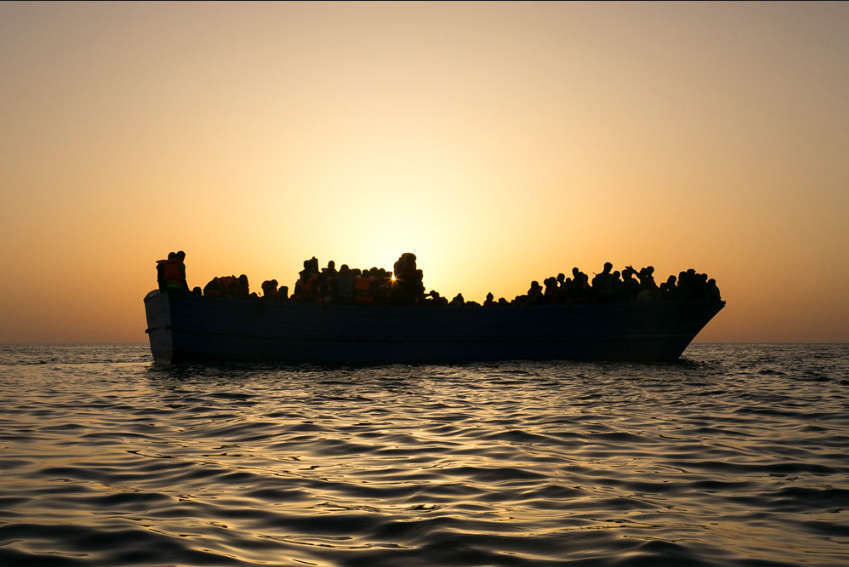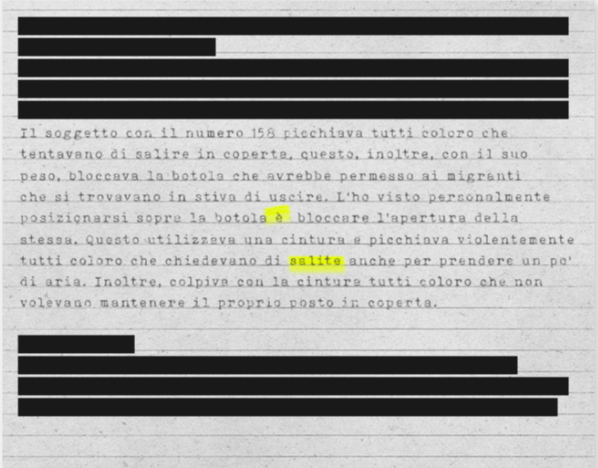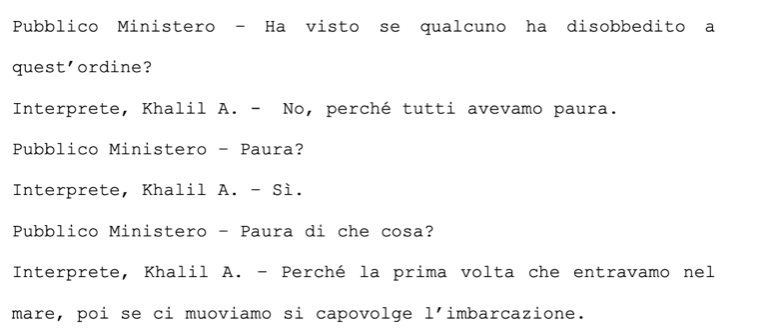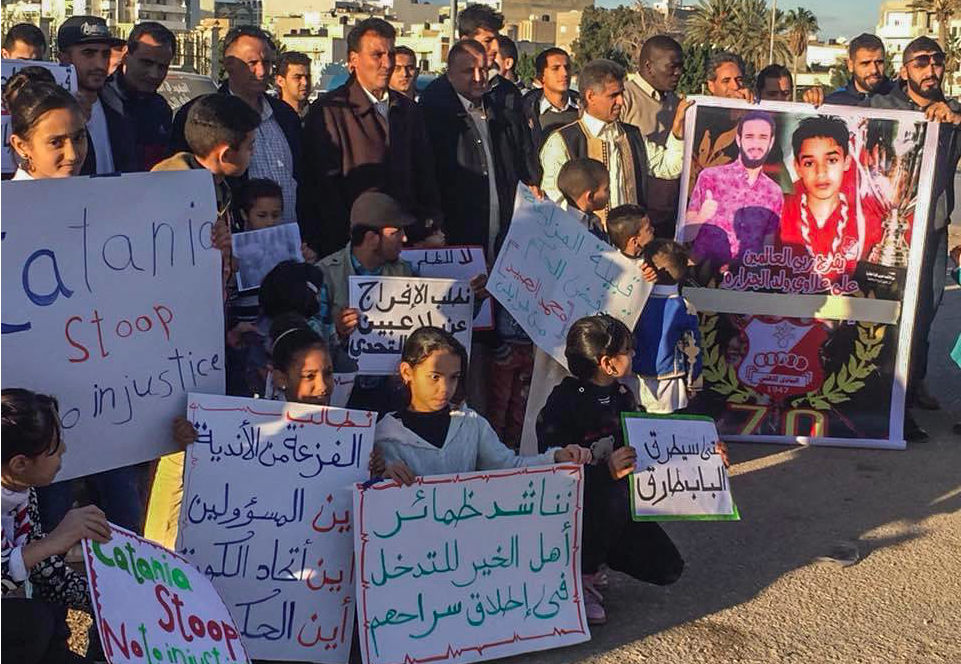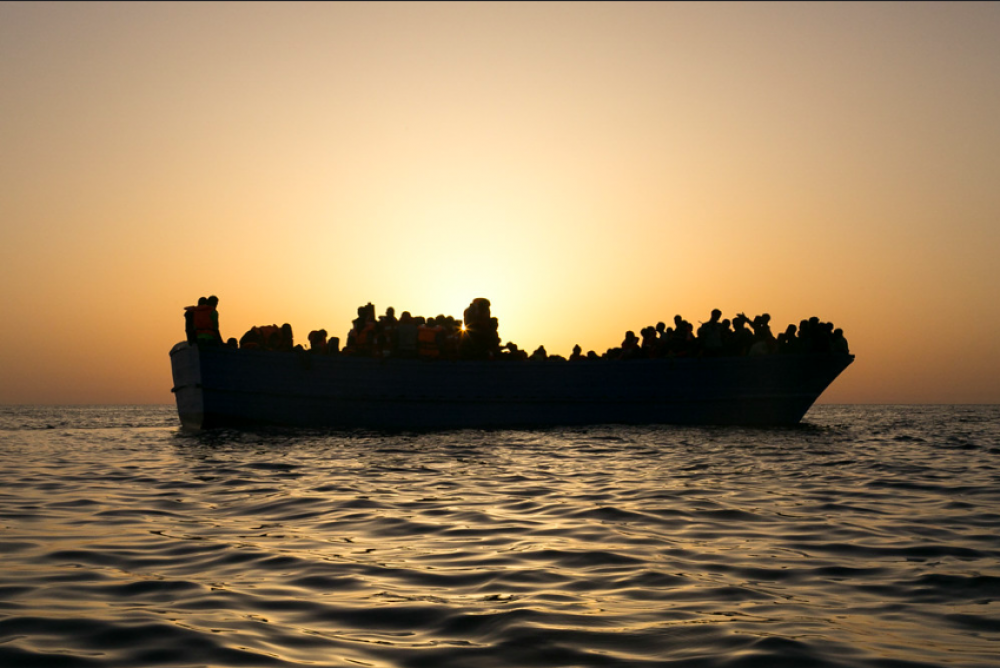Article: Inside Italy's show trial against Libyan 'boat drivers'
Eight survivors of a deadly Mediterranean shipwreck - among them 4 Libyan football players - were wrongly convicted for murder. This is how the investigation and trial unfolded.
© Symbolic Foto by Sea Watch Org.
Author: Lorenzo D'Agostino.
Published in Italian by IrpiMedia.
Translated by Watch the Med - Alarm Phone.
Read the original version here.
On the 15th of August 2015, 49 people died of asphyxia below the deck of an overcrowded wooden dinghy as they tried to flee Libya. Because of this incident, eight people, the alleged “crew” of the dinghy, were put on trial and convicted in Italy for people smuggling and murder. The case against five of them will be heard by Italy’s high court on Friday 2 July 2021.
The Libyan nationals, Jomaa Laamami Tarek, Abdelkarim Alla F. Hamad, Abd Al Monssif Abd Arahman, Moroccan citizen, Beddat Isham and Jarkess Mohannad, from Syria, on appeal, were sentenced to 30 years. Assayd Mohamed, from Libya, Couchane Mohamed Ali, from Tunisia, and Said Mustapha, from Morocco, received 20 year terms after their lawyers negotiated a deal to shorten their sentence.
Five of these men were younger than 20 when, on the basis of witness statements from nine of the 313 survivors of the sea crossing, they were arrested upon their arrival in Italy on the night of 17 August 2015.
These convictions, and the police investigations, were based on the groundless assumption that a crew responsible for the deaths was hiding among the passengers of the dinghy. These were said to be a group of ruthless traffickers who were a part of the Libyan organisations that smuggle people across the Mediterranean Sea.
The trial was based on unproven hypotheses, counterfeit police reports, and leading questioning of traumatised witnesses. This was not an isolated miscarriage of justice, but, as we are able to reveal through an analysis of police reports, handbooks used by law enforcement, and the minutes of private meetings among the highest echelons of the Italian judiciary, a tactic which is routinely used in migrant smuggling cases.
It is a method devised by Italy’s Antimafia Directorate and prosecutors that allowed the state to hold a convenient scapegoat responsible for the deaths in the Mediterranean.
The manual for investigations on the high seas
Since 2013 there has been an attempt to standardize the approach to combat human trafficking, with the prosecutor's office in Catania (led at the time by prosecutor Giovanni Salvi) leading the experiment. The guidelines adopted by the National Anti-Mafia Directorate (DNA) in October that year foresaw sending out "investigative teams on the high seas", i.e. in international waters. This constitutes "a new and unexplored judicial path ... a synergistic system of new national and international coinage that speaks of the high professionalism of the Catanese DDA and its Chief," according to the report of the DNA of that year.
Indeed, the method introduced by Salvi quickly caught on in a Europe increasingly concerned about boat landings. Today it is officially adopted by the EU’s patrolling missions, such as EUNAVFOR MED - managed by the Navies - and Themis - coordinated by Frontex, the European Border Patrol Agency, together with Italy.
In the case of the mid-August shipwreck, the attempts to identify the crew of the boat started in the first few hours following the 2015 Search and Rescue (SAR) Operation 1046 coordinated by the Capitaneria di Porto (MRCC) in Rome. The 313 survivors of the shipwreck were rescued by the Italian Navy patrol boat, Cigala Fulgosi in the morning, but the captain Massimo Tozzi did not have a refrigerated container on board where he could have kept the 49 found bodies. He therefore requested the help of a ship of the European Union border agency, Frontex, the Norwegian tug boat Siem Pilot, to which the survivors were also transferred.
After the search for the dead bodies had been concluded, a third military ship, the German OPV Werra, transferred to the Siem Pilot another 103 persons who had been rescued just a few hours before. The Frontex tug boat was then ordered to head towards the port of Catania. At 6:00 am on the morning of the 17th, when the Siem Pilot was already off the coast of Syracuse, five officers of the Catania Police and Guardia di Finanza who specialise in the fight against organized crime were sent on board to interrogate the shipwrecked people.
This experimental approach is supposed to allow the directorate to gather valuable information to dismantle organizations dedicated to smuggling and trafficking in persons ahead of the criminal investigations. Following this new method of inquiry, in practice, the job of the agents on board the rescue ships was to select, among the shipwrecked people themselves, the suspected "crew members" belonging to the criminal organization.
For this reason, Frontex agents immediately opened a "crime scene investigation", even collecting swabs from the boat's bridge for possible DNA testing, which were then handed over to the Italian police. But they were never analyzed: in order to find the smugglers, the agents resorted to quicker methods.
As a matter of fact, they applied the guidelines of the EUNAVFORMED mission whose title in Italian is “Profiles of Vulnerable Persons & Smugglers/Traffickers”. According to the manual, the smugglers will “try to disguise themselves among the migrants when the boat is intercepted". In order to avoid being deceived by the smugglers, the manual suggests that agents "interrogate women with underage children first".
This investigative technique - relying on behavioral or physical indicators to filter potential suspects - is called "profiling." EUNAVFORMED's manual says it should only be used by agents trained in the subject and warns of its risks: "This profiling should never be used in a way that would fuel discrimination." Further on, "Indicators are not evidence; they are the starting point for further investigation."
The slideshow which can be found in the original article shows important excerpts of the minutes of the investigation written by Frontex Agents and officers of the judicial police of Catania. They demonstrate the use of profiling in practice, however, they also constitute the entire investigation rather than its “starting point”.
"Chief Insp. Macaluso Santo first entered the space called the "Red Zone" and noticed that about 9-10 male subjects were rejected and driven away with screaming and pushing when trying to join the other migrants”, according to the notes of Vice-Petty Officer Giovanni Arcidiacono. “The mentioned migrants were grouped in a corner, obviously afraid and curious about the activities carried out by this police unit, following every movement with a strange interest. They were talking exclusively among themselves.” This observation, which is a mere investigative cue, has been used as fundamental evidence in the process.
Here you can find a detailed timeline.
During the hearing, other statements by the inspector were considered to be independent corroboration of the survivors' accounts. Without independent corroboration, a clue reported by a witness cannot be considered as evidence. In the courtroom the inspector reported to have noticed "a strange movement of some migrants who were distinguished from the others by the color of their skin” when he was on board the Siem Pilot. “They were much lighter than the others, while the others were very dark, black".
The defense focused on the inconsistencies of Macaluso's declarations, from comments about the skin color of the suspects, to the fact that on board the Siem Pilot there were migrants from two separate rescue operations. The Court of Appeal, however, considered him credible.
borderline-europe started a campaign and published the full letters sent by Ali und Muhanad from prison:
Ali: Show the people who love us that we are innocent!
Muhannad: I lost everything
The interrogations
Despite the double mediation of the interpreter and the bureaucratic language of the police, the personal accounts are full of details. For example, one Ivorian witness recounts the days leading up to her departure:
"On Monday the 10th of this month, at about 2 a.m., two Libyans came to the house and picked up the three of us - my brother, my sister-in-law and me - and when they arrived at another house they only dropped off me and my sister-in-law, while my brother stayed with the Libyans". This is the testimony of another Moroccan: "I worked for about six months in Libya as a mason to save enough money to pay the smugglers. I gave the money to my compatriot Nassim, who, on Friday 14 August, took me to Zuwara in a van. What emerges from all these testimonies is a coherent description of boarding and departure. On the night of 14 August, armed Libyan smugglers rounded up hundreds of migrants from various collection centres and gathered them on the beach. They transported them in a rubber dinghy in groups of 30, and embarked them on a wooden boat moored offshore. They started with sub-Saharan Black men, who were forced into the hold, already filled with fumes from the running engine. Besides them, there were people from Pakistan and Bangladesh for whom the smugglers reserved the worst seats on board. This reconstruction is credible because it matches what other survivors have already testified: in addition to women and children, other Arabic people (Libyans, but also Moroccans, Tunisians and Egyptians) travelled above deck, following a racist logic of seat allocation. At the end of the boarding operations, which lasted a few hours, the smugglers left the boat and returned to land in their rubber dinghies. Until the transfer to the Siem Pilot, no one above deck realised that 49 people had lost their lives in the hold,
After taking these testimonies, the investigators had the interviewees consult two folders of pictures. In the first, the five witnesses who claimed to have lost a relative could not identify anyone. In the second, all the witnesses (except for the Sudanese man who was below deck) recognised some 'crew members'. The latter are accused by the survivors of having violently prevented those below deck from coming up for air, thus causing their death. There is no way of knowing what questions were asked to the survivors, because the minutes only contain a list of accusatory statements preceded by the letters "ADR", A Domanda Risponde - namely: ‘To the question, they answered’.
Several elements of these statements are not convincing. In fact, some excerpts from the interrogation are repeated verbatim across testimonies.
The same sentences are found in five reports, including, "I recognise the person bearing the number 157 as the master of the vessel, the one who steered the vessel throughout the crossing" or the variant "In the picture, I recognise the face bearing the number 157 as the master of the vessel, the one who steered the vessel throughout the crossing". The wording "I also remember that he gave frequent instructions to the persons I recognised under number..." is repeated with the persons identified by numbers 270, 201, 186, 156 and 153 (five of the eight defendants).
Adding to the suspicion that there might have been a judicious use of ‘copy-paste’ is the fact that in two interrogations typing errors are repeated, for example: 'I personally saw him stand over the trap door and [misspelled in Italian] block it from opening. He used a belt and violently beat all those who asked to go up [misspelled in Italian] to get some air". Moreover, three others contain five identical answers (see slideshow).
R.C. Minutes, August 17, 2015, 6:20 p.m. © Lorenzo D'Agostino
The pretrial hearing
On 21st and 24th August, eight of the nine witnesses appeared before the judge in Catania to be cross-examined by the public prosecutor and the defence. This procedural stage is called "incidente probatorio" (pretrial hearing): it allows the evidence, which in this case was the police identifications, to be "crystallised".
During the pretrial hearing, it became clear that this trial would follow the pattern of mafia trials. Two elements demonstrate this: the first is the promise of a protection mechanism for those who cooperate (specifically, as in other similar proceedings, witnesses are granted a residence permit); the second is the decision to protect witnesses by placing them in a booth. It was intended to prevent the accusers and accused from coming face to face, due to fear of repercussions or threats. As a result, the identification of the crew members took place only through photo albums and not in person. However, both prosecutors and the defence agreed to conduct the trial in this manner.
From the pretrial transcript of the cross-examination, several weak elements of the testimonies emerge, although the defendants’ lawyer did not seem able to highlight them.
The first unconvincing elements concern the identification of the alleged crew. A Pakistani witness reported some people in uniform ('with a different jacket from everyone else'). An Ivorian woman spoke of whistles used by the crew to maintain order. These two details are not mentioned in any other testimony. Another telling moment is when a Moroccan witness claims that he was recognised by the crew during the night because of "the light of the moon". But there was a new moon on the night of 14 August 2015. It is one of many obviously erroneous details that is left completely unchallenged.
Witness statements about the size of the crew are also contradictory. Again a Pakistani witness:
Public Prosecutor - Do you remember how many people you recognised?
Interpreter, Khalil A. - Yes, three, five I could identify them, recognise them.
Prosecutor - No, how five!?
Interpreter, Khalil A. - Three or five. Three, four indeed.
The problems continued with the photographic recognition. In the album in front of him, the witness pointed to a photo that did not correspond to any of the eight defendants and which he himself had never previously said he recognised:
Interpreter, Khalil A. - 164 - for which there is no signature, however, he immediately
Says - this is it, this is it. This was one of the guards who was beating on top. He was on top, he also hit on top, because he is one of the guards.
Public Prosecutor - So he also hit the people who were on top, in the upper part of the boat.
Judge - But this is not one of the suspects.
Interpreter, Khalil A. - So, he beat those who tried to go upstairs.
Judge - Let's go on.
Public Prosecutor - He must check if he recognises his own signatures.
Public Prosecutor, Dr La Rosa - He has to check again the photos in which he puts his own signatures.
Judge - Exactly. Let's not digress. It is important from a procedural point of view.
Another Moroccan witness did not even recognise his own signatures ('I did not put any initials'), while an Ivorian woman denied having made any photographic recognition in front of the police, confirming the state of shock in which she found herself less than five days after the shipwreck and the death of her brother. She also added that she had not witnessed any acts of violence, contrary to the police report. She then withdrew her accusations against the defendants, pointing out that the smugglers who had loaded the migrants into the boat had then returned to Libya.
A Sudanese boy who travelled in the hold spoke of people on board asking the others not to move. No one disobeyed 'because,' he says, 'we were all afraid' that the boat would capsize, not because of threats or beatings. From these words, it emerges that there was no act of organised violence to force people to stay below deck. At most there was a struggle to maintain each one’s position on board an overcrowded and precarious boat, loaded to the gunwales by smugglers who remained in Libya. This reconstruction is consistent with the coroner's examination, according to which 'none of the 49 bodies examined showed evidence of recent traumatic injuries of any appreciable extent'.
© Lorenzo D'Agostino
The rulings
If putting oneself at the helm of a boat to seek a better life in Europe is to be considered a crime, the only one of the eight defendants about whom there is any serious indication of guilt is Couchane Moahmed Ali.On the night between August 14 and 15, 2015, Couchane, by his own admission, piloted the boat on which 49 people lost their lives. He did so without availing himself of the assistance of any “crew”. But to Couchane's confession, the courts have preferred the accusatory material produced by the Police, Guardia di Finanza and the Public Prosecutor's Office.The accusatory statements are inconsistent, contradictory, and given by exhausted, traumatized and sometimes tearful witnesses, in one case even without an interpreter.
This, however, was not the the view taken by the Court of Appeal: "The depositions were made in the immediacy of the rescue... and then they were repeated with accuracy and coherence... during the pretrial hearing, without registering particular states of mind such as trauma, desperation or inability to express oneself that could have suggested a mental disturbance such as toaffect the reliability of the witnesses".Do the statements from the pretrial hearing contradict those in the Summary Witness Information? This should have been pointed out by the attorneys at the pre-trial hearing, but as they did not do so, the Court of Appeal says that there are no contradictions, so only the last statements count as evidence.Witnesses who occupied the most distant and disparate positions on the barge claim to have been able to identify the same crew members in the dark of night because of their proximity, and invent imaginative details about whistles and uniforms.
The Court of Appeal dismisses these problems as, "Discrepancies or divergences of detail."Is the profiling carried out by inspector Santo Macaluso mere innuendo and not based on factual data? On the contrary, the "evidentiary relevance" according to the Court of Appeal of Catania is "irrefutable": "The repulsion towards the smugglers, of generalized character because it came from people belonging to different ethnic groups, is explained ... with the attribution to the conduct of the defendants of the serious events that occurred," write the judges in the ruling.In the final submissions in the appeal process, the Attorney General stated: "There is no escape from this alternative: either they are smugglers or they are migrants".
In convicting, the Court of Appeal of Catania contradicted him: "The motivations that had pushed each of them to leave Libya devastated by war, as well as the payment for the journey to reach Europe, are to be considered true". But nor have links with criminal organizations in Libya, for example the mafia of Zawiya or groups then active in Sabratha and Zuwara, been found. Nevertheless, according to the judges, this does not affect the guilt of the accused.
The parallel diplomatic file
Throughout 2020, the judicial procedure was intertwined with broader diplomatic relations between Italy and Libya.
In September 2020, 18 Sicilian fishermen were arrested by the authorities in Benghazi, in the area under the control of General Khalifa Haftar. They were arrested on false charges of drug trafficking and illegally entering Libyan territorial waters. In exchange for their release, the local government demanded the release of four of the eight defendants who, according to the Libyan authorities, were Libyan footballers falsely accused of human trafficking by Italian courts.
The Catania Public Prosecutor Carmelo Zuccaro said the prisoner exchange prospect was ‘a provocation. He said to the Italian newspaper ‘Corriere della Sera’ that the case ‘had nothing to do with young footballers’. Zuccaro stated: ‘They were condemned not only for being in command of the boat, but also for murder, having caused the death 49 migrants held in the hold. The 49 migrants were left to die in a ruthless manner. They were mercilessly left to die, the hatchway was bolted so as to not let them on deck. One of the most brutal episodes ever recorded.’
The exchange did not take place. In December last year, the then Prime Minister Giuseppe Conte and Foreign Minister Luigi Di Maio went to Benghazi and obtained the release of the prisoners through controversial negotiations with the warlord Khalifa Haftar.
The end of that crisis has not, however, defused Libya's demand for the extradition of the convicted Libyans to Italy. As a spokesman for the Italian Ministry of the Interior told to IrpiMedia, the authorities in Tripoli and Benghazi raise the problem in almost all bilateral meetings with Italy: "For years now they have been asking for a procedure for those sentenced in their respective countries to serve their sentences in their countries of origin".
For the time being, Italy has not complied with the request, given the political importance, of bringing smugglers to prison. Even when the evidence does not reach the threshold of reasonable doubt'.
Other cases:
Between 2014 and 2015, with the consolidation of the investigative methods of the Anti-Mafia District Directorates, alleged 'crew members' were brought to trial for all major boat arrivals, especially those with victims. The accusations - such as the use of belts and sticks to keep order on board - often resemble each other, and the methods of investigation have been standardised.
These are some examples:
28 August 2015. Frontex ship Poseidon retrieved 494 shipwrecked people, including 53 bodies. The Italian liaison officer on board pre-selected eight suspects. Upon disembarkation in Palermo, an Italian police officer saw "the 'witnesses' shouting at the suspects, who had disembarked last, and pointing at them". They were all acquitted. The Court considered that "the identification of the suspects, with the exception of the driver, was the result of mere chance".
5 August 2015. The Irish navy ship L.E. Niamh rescued 367 shipwrecked people, recovering 26 bodies. On the ship, which disembarked in Palermo, Italian police gave a bracelet to five shipwrecked people, marking them as 'suspect' and keeping them out of sight of the other survivors. Witnesses then recognised the five people from a photo album in which the 'suspect' bracelet was clearly visible. All but the driver were subsequently acquitted.
19 July 2014. The Danish merchant ship Torm Lotte rescued 569 people. There were hundreds of victims. The police of Messina, who boarded the ship, selected a group of five suspects and disembarked them separately: a group of witnesses would go on to accuse them of kicking and whipping people with belts and distributing water bottles. They were sentenced to 30 years.

